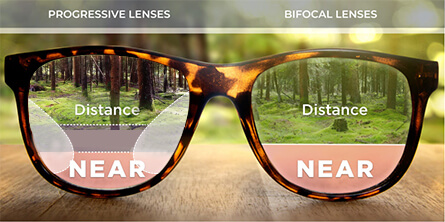Bifocal Lenses VS Progressive Lenses
Bifocal literally means “two focuses”, which contains two different prescriptions: an upper section to allow for distance vision and an additional power on the bottom part of the lens to aid in close up focus. The result is vision clarity at both distance and near with one pair of glasses.
However, the intermediate distance of bifocal glasses has poor visual effects. Produce an “image jump” phenomenon and have a poor appearance. Due to its own major shortcomings and the popularity of progressive lenses, bifocal lenses have been basically eliminated.
Progressive lenses are developed on the basis of bifocal lenses. In addition to not having to remove the glasses, the wearer can also move the line of sight gradually between the upper and lower focal lengths when observing the far/near objects. The eyeball needn’t constantly adjust the focal length, and there is no obvious dividing line between the two focal lengths.

For the crowd
Progressive lenses are suitable for the following crowd:
▪ Myopia control lenses for teenagers -- used to alleviate visual fatigue and control the development speed of myopia.
▪ Anti-fatigue lenses for adults -- for teachers, doctors, and people who use too much proximity and computers to reduce visual fatigue at work. And it eliminates bothersome "image jump" caused by bifocals.
▪ Progressive lenses for middle-aged and elderly -- a pair of glasses which is easy to see near and far. In addition, they have the same beautiful appearance as single lenses.
How to get used to progressive lenses
▪ Look far, then focus on something closer as you lower your eyes to the mid part of the lenses.
▪ Then, take a book and look through the bottom of the lenses.
▪ Next try moving your head and not just your eyes up and down and side-to-side as you look through the different fields of vision.
▪ Remember to use your head to point towards where you wish to look.
▪ Please note that if you look through the corners of the lenses, they will always seem a bit blurry. That’s completely normal!

Notices for wearing
1. When choosing the frame, you'd better choose a large frame. Because the lens is divided into far, middle and near zones, only large frames can ensure a wide enough zone for the near part. Since the learger the lens is, the thicker the edge of lenses will be, it is best to choose a full frame, which can cover the thickness of the edge of the lens.
2.Generally, it takes about a week to adapt, but the length of the adaptation period varies from person to person. When you feel dizzy, you should walk slowly. Since both sides of the lens are astigmatic disorder areas, it is not clear to see objects on both sides through the light of the eyeball, and it is necessary to turn the neck and the eyeball to see objects at the same time.
3. When going downstairs, the glasses should be lower and you should try to see from the distance zone.

























